

What is Resistance?
Catalog
What is Resistance?Calculating ResistanceWhat Are Resistors?Methods for Measuring ResistanceTypes of Materials and Their ResistanceExample of Circuit ResistanceWhat to Know About Measuring Electrical ResistanceHow Resistance Relates to OhmsUsing Resistance Measurements for TroubleshootingCommon Problems Detected with Resistance MeasurementsWhy Resistance MattersRelated ArticlesResistance refers to how much a material or component resists the flow of electrical current in a circuit. Factors such as the type of material, its length, thickness (cross-sectional area), and temperature all affect its resistance.
Electrical resistance is measured in ohms (Ω), a unit named after German physicist Georg Simon Ohm (1784–1854). Ohm is best known for discovering the relationship between voltage, current, and resistance, now known as Ohm’s Law.
Want to know how to measure resistance with a digital multimeter? Check out our detailed, step-by-step guide next.
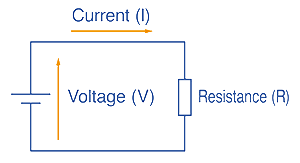
Ohm’s Law
This illustration shows how electrical resistance relates to both current and voltage.
What is Resistance?
Electrical resistance is the opposition to the flow of electric current. In other words, it shows how difficult it is for current to move through a material or circuit. Resistance is measured in ohms (Ω).
When there’s a difference in electrical potential between two points, current flows from the higher potential to the lower potential. Resistance works against this flow—higher resistance means less current, while lower resistance allows more current to pass.
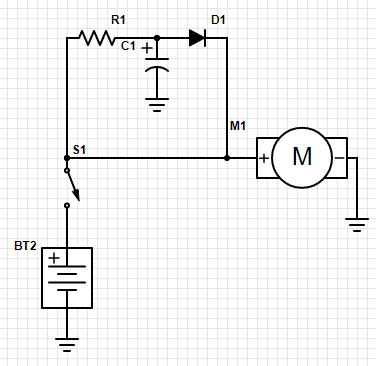
What is Resistance
Calculating Resistance
You can determine resistance in a circuit by dividing its voltage by its current:Resistance=VoltageCurrent\text{Resistance} = \frac{\text{Voltage}}{\text{Current}}Resistance=CurrentVoltage

Ohm’s Law
This relationship is called Ohm’s Law. If voltage stays the same, resistance decreases as current increases, and increases as current decreases. In simple terms, circuits with large currents have low resistance, while those with small currents have high resistance.
In practice, resistance depends on several factors:
- Material type: Electricity flows more easily through metals because they have low resistance. Among common metals, resistance generally increases in this order: silver → copper → gold → aluminum → iron.
- Temperature: Most materials have higher resistance at higher temperatures and lower resistance at lower temperatures.
- Conductor length: The longer the conductor, the greater its resistance.
- Cross-sectional area: A thicker conductor has lower resistance, while a thinner one has higher resistance.
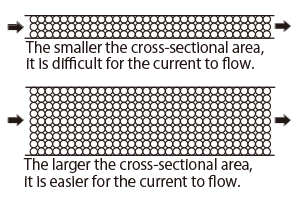
What Are Resistors?
Resistors are electronic components designed to oppose the flow of electric current in a circuit. They work much like a faucet controlling the flow of water—adjusting how much current passes through and helping to distribute voltage where needed.
In electrical circuits, resistors are essential for maintaining proper operating conditions. They are made from materials that naturally resist the passage of electricity, allowing them to control current levels throughout the circuit. When a resistor reduces current flow, the excess electrical energy is released as heat.
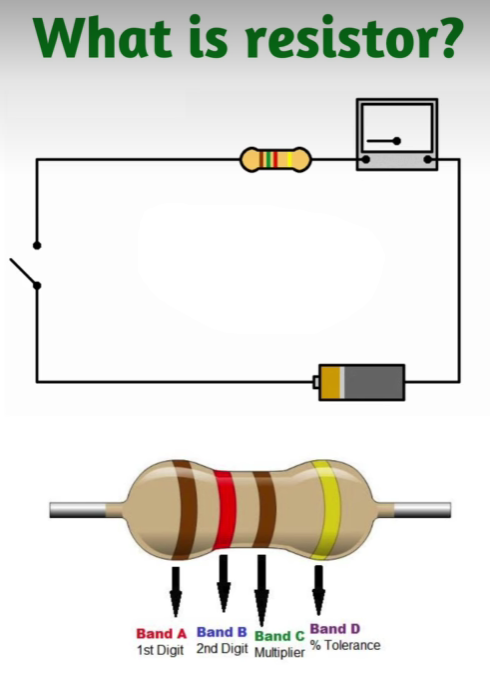
Resistors come in several forms, with the main types being:
- Fixed resistors – have a set resistance value that does not change.
- Variable resistors – allow the resistance to be adjusted.
- Potentiometers – a type of variable resistor often used to control voltage levels.
The main types of fixed resistors include carbon-film resistors and metal-film resistors, which use a coating of carbon or metal, respectively. These components have a set resistance value that does not change.
Variable resistors, on the other hand, allow their resistance to be adjusted. Potentiometers are a specific type of variable resistor designed to fine-tune voltage and current in a circuit.
Methods for Measuring Resistance
Resistance in a circuit can be measured with a digital multimeter—a versatile tool that can also measure voltage, current, and other electrical parameters.

To measure resistance:
- Turn on the multimeter and set it to resistance mode (Ω).
- Select the appropriate range based on the expected resistance value of the component.
- Plug the red test lead into the “Ω” terminal and the black test lead into the COM terminal.
- Touch the test leads to both ends of the resistor.
- Read the measurement on the multimeter’s display.
- Once done, disconnect the test leads from the resistor.
Resistance readings can be influenced by factors such as temperature. Some digital multimeters include features to correct for these effects—for example, a temperature compensation function. When choosing a multimeter, it’s worth checking if it offers this capability.
Resistors play a crucial role in controlling the flow of current in a circuit. Resistance, measured in ohms (Ω), indicates how easily current can pass through. When resistance goes down, current goes up—and when resistance goes up, current decreases. Resistors help keep current at the right levels to ensure circuits work properly. Different types of resistors are used depending on the specific application.
To check if resistors are functioning correctly, a digital multimeter is an essential tool. Why not give it a try and measure resistance using the method described earlier?
Types of Materials and Their Resistance
Every material resists the flow of electric current to some extent. In general, most materials can be grouped into two main categories:
- Conductors: These materials have very low resistance, allowing electrons to flow freely. Common examples include silver, copper, gold, and aluminum.
- Insulators: These materials have high resistance, making it difficult for electrons to pass through. Examples include rubber, paper, glass, wood, and plastic.
Factors That Influence Resistance
Resistance measurements are often taken to check the health of a component or an electrical circuit.
High Resistance – Cause and Effect
When resistance increases, current flow decreases. If resistance is unusually high, one possible reason could be damaged conductors—often caused by burning or corrosion. Since all conductors produce some heat during operation, overheating is a common issue linked to high resistance.
Low Resistance – Cause and Effect
Lower resistance allows more current to flow. Abnormally low resistance can be caused by damaged insulation, often due to moisture exposure or excessive heat.
Fixed-Resistance Components
Some components, like heating elements and resistors, are designed with a specific resistance value. These values are usually printed on the component’s nameplate or listed in the equipment manual.
If a tolerance is provided, the measured resistance should fall within that specified range. A large deviation from the fixed value typically signals a fault.
Why Resistance Can Be Useful
Although “resistance” might sound like a problem, it can be put to good use in electrical systems.
For example, the thin coils in a toaster have high resistance, which restricts current flow and generates enough heat to toast bread. Similarly, traditional incandescent light bulbs force current through fine, high-resistance filaments, producing heat and light.
Measuring Resistance in Circuits
Resistance cannot be measured directly in a live circuit. Instead, technicians often measure voltage and current, then apply Ohm’s Law to calculate resistance:E=I×RE = I \times RE=I×R
This means voltage (E) equals current (I) multiplied by resistance (R). If resistance is unknown, the formula can be rearranged to:R=EIR = \frac{E}{I}R=IE
(ohms = volts ÷ amps)
Example of Circuit Resistance
In an electric heater circuit, as shown in the two diagrams below, resistance is calculated by measuring the voltage and current, then applying Ohm’s Law.
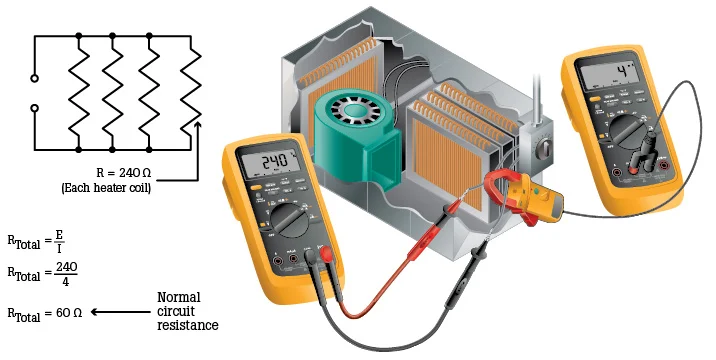
normal circuit resistance
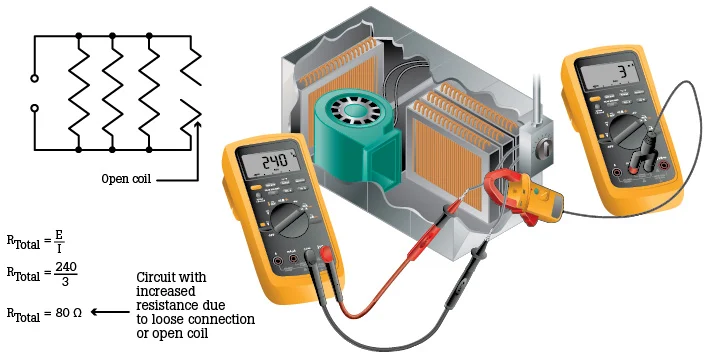
increased circuit resistance
In the first example, the normal total circuit resistance—a known reference value—is 60 Ω, calculated as 240 V ÷ 4 A = 60 Ω. This reference resistance can be used to help assess the health of a circuit.
Increased Circuit Resistance
In the second example, if the circuit current drops from 4 A to 3 A, the total resistance rises from 60 Ω to 80 Ω (240 V ÷ 3 A = 80 Ω). This 20 Ω increase could be the result of a loose or dirty connection, or a partially open coil. Such open-coil sections raise the total circuit resistance, which in turn reduces current flow.
What to Know About Measuring Electrical Resistance
Depending on how your measuring tool displays results—whether in ohms (Ω), kiloohms (kΩ), or another unit—your readings may look different. Electrical resistance can be measured using either a multimeter or an ohmmeter. A multimeter is a versatile device capable of measuring voltage, current, resistance, and sometimes other parameters, depending on its design. An ohmmeter, by contrast, is dedicated solely to measuring resistance.
How Resistance Relates to Ohms
Electrical resistance is measured in ohms, symbolized by the Greek letter Ω.
One ohm (1 Ω) is defined as the resistance between two points when a voltage of one volt across them produces a current of one ampere.
Using Resistance Measurements for Troubleshooting
Measuring electrical resistance is a simple yet powerful way to check whether a component or circuit is functioning correctly.
By taking resistance readings at various points in a circuit, you can locate faults faster and restore proper operation. Issues such as failed components, loose connections, or damaged insulation can often be identified through resistance testing.
Common Problems Detected with Resistance Measurements
Resistance measurements can help uncover:
- Open or short circuits: Very high or infinite resistance indicates an open circuit, while extremely low or zero resistance points to a short circuit.
- Failed components: Components with a known resistance value, such as resistors, can be tested to see if they are still within specification.
- Overheating parts: Higher-than-normal resistance can signal components that are overheating and potentially failing.
- Voltage drop problems: Measuring the resistance of wiring can help locate damaged sections or loose connections that need repair.
Why Resistance Matters
Resistance plays a critical role in controlling current flow in electrical systems. It can also be a valuable diagnostic clue, revealing poor connections, incorrect installations, or faulty components.
While resistance can be calculated using Ohm’s Law, it can also be directly measured with tools like a multimeter or ohmmeter. Knowing how to measure resistance correctly will help you troubleshoot electrical issues more effectively and keep systems operating safely and reliably.
Related Articles
What is a Complementary Metal Oxide Semiconductor (CMOS)?
Parallel Resistor Calculator & A Practical Guide for Electrical Engineers
Network Analyzer vs. Spectrum Analyzer:Use & Specifications
How to Determine Capacitor Polarity
How to Test a Fuse Using a Multimeter
How to Check Current With a Multimeter
How to Operate a Voltage Tester
Electrical Measurements: Common Types, Tools, and Calculations
Subscribe to JMBom Electronics !













